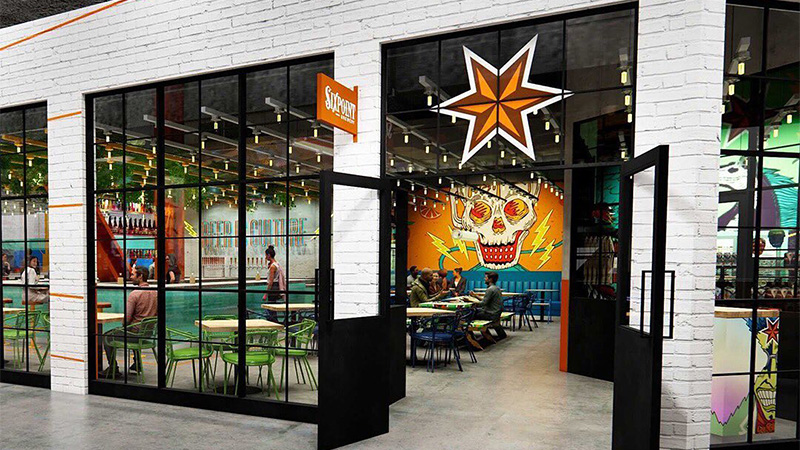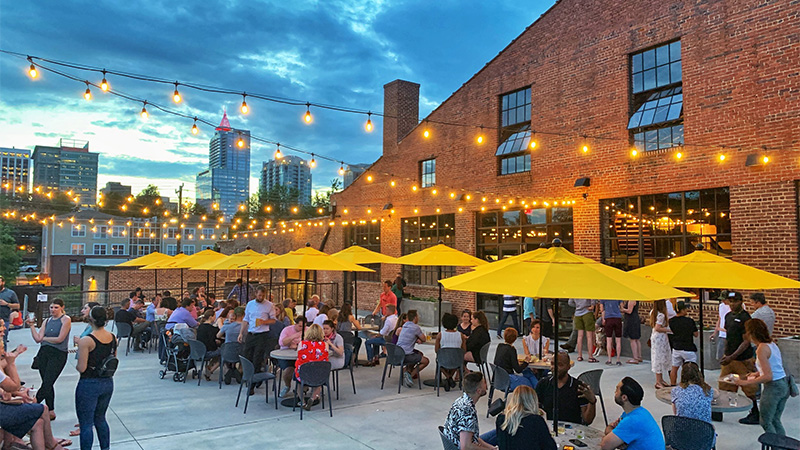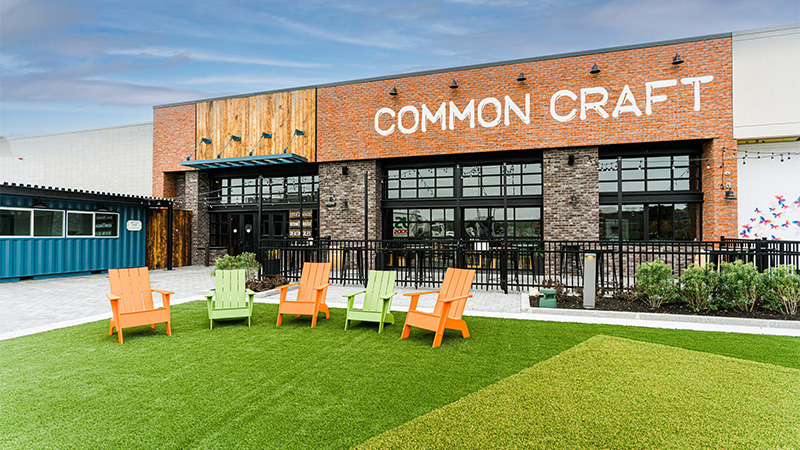Breweries often experience unexpected delays when building a taproom. Waiting months is common, no big deal. A year is a bummer. Nearly two decades? That’s the story of Sixpoint.
The Broolyn-born brewery began making beer in 2004, focusing on distributing its Sweet Action pale ale and Bengali IPA in kegs and eventually cans. Omitting a taproom was no oversight. Longstanding New York State laws made it difficult for breweries to open taprooms and pour pints for patrons.
A 2014 law change lowered the hurdles to opening taprooms, but Covid-19 and other challenges waylaid Sixpoint’s brick-and-mortar dreams. “We’ve been looking in the New York market for three or four years,” says Gary Bryant, the executive vice president of Artisanal Brewing Ventures, now Sixpoint’s parent company.
Don’t Miss A Drop
Get the latest in beer, wine, and cocktail culture sent straight to your inbox.
The hunt ended in downtown Brooklyn’s City Point, a mixed-use development that’s home to the subterranean Dekalb Market Hall. This fall, Sixpoint will open its first taproom beside a Trader Joe’s, a satellite location of Katz’s Delicatessen, and food stalls serving plump arepas, hand-pulled Chinese noodles, and more.

After stocking up at Trader Joe’s, shoppers can unwind inside the brewery’s enclosed taproom with a Resin double IPA that’s poured, just right, by Sixpoint staff. “We’re able to participate in that environment of a food hall,” Bryant says, and still “control the dynamics inside the four walls.”
During the craft brewing boom of the 2010s, brewery taprooms drew in curious drinkers like a tractor beam, the attraction nothing stronger than fresh IPAs and barrel-aged imperial stouts. “There was a period of time during the heyday when having beer was enough,” says Clay Robinson, the CEO and a founder of Sun King Brewing, which operates multiple locations across Indiana and now Florida.
Nowadays, pretty great beer is sold everywhere, and umpteen brewery taprooms are competing with one another. To reach broader audiences, breweries are increasingly opening taprooms inside food halls and malls, finding that bustling foot traffic, ample dining, and complementary shopping options can attract customers for a couple cold rounds.
“Great food options can bring people in to have beer,” says Robinson.
Food Halls Make Space for Taprooms
Many food halls are centrally located in cities and can offer variable square footage for tenants, two factors that can make or break a brewery taproom. Burial Beer opened in Asheville, N.C., in 2013, and has since added additional locations in Asheville, Charlotte, and Raleigh, where the brewery opened an outpost in the more than 50,000-square-foot Transfer Co. Food Hall in early 2019.
Burial started small, turning a 670-square-foot chunk of the former garage into an art-filled narrow taproom for guests to drink its hop-forward ales then purchase packaged beers to go. As demand grew, Burial took over an adjoining empty space, and then another one, letting the brewery create a dedicated bottle shop and taproom.
“The food hall has allowed us to continue to expand our space,” says Chris McClure, Burial’s director of brand.
At their core, food halls are culinary incubators. The business models and buildings are built on a plug-and-play model that lets entrepreneurs test new concepts, even a production brewery.
Javi Pérez began homebrewing in Berkeley, Calif., in the late 1980s, an ideal synthesis of food and science for the emergency room physician. Javi and his wife, Jen, eventually settled in Denver, where the duo decided to turn his long-fermenting hobby into a community-driven brewery inspired by the culture and culinary heritage of Oaxaca, Mexico, home to Javi’s paternal grandparents.

The couple homed in on neighboring Aurora, and city officials steered the couple to the Stanley Aviation factory. Developers were looking to turn the dilapidated property into Stanley Marketplace, with the goal of helping small entrepreneurs get a leg up. In late 2016, the couple opened Cheluna Brewing with a vibrant taproom decorated with colorful tiles behind a bar serving beers like Coco-Xoco, a porter inspired by the coconut-packed Mexican sweet cocada. (The brewery’s name is a portmanteau of “chela,” Spanish slang for beer, and “luna,” or moon.)
A special license lets customers stroll around while drinking Cheluna’s beers, and marketplace customers will often grab a beer after getting a haircut or a new shirt, or maybe it’s after lunch with friends. “It’s synergistic,” Pérez says.
In the pre-Amazon years, the American mall offered everything a consumer’s heart could desire, be it bedding at J.C. Penney or a Beastie Boys CD from Camelot Music. Food courts were repositories of burgers, fries, pizza, and other greasy fast food — mere fuel before buying more stuff.
As property owners look to revitalize and reinvent malls as lifestyle centers for entertainment and amenities, they’re turning to breweries to serve as anchors and attractions. This spring, Steel Leaf Brewing opened inside a former Dave & Buster’s in the Eastern Hills Mall near Buffalo, N.Y. In July, Migration Brewing installed a pop-up beer garden at the Washington Square mall in Portland, Ore. And in Burlington, Mass., the Burlington Mall turned a portion of a former Sears department store into Common Craft. The concept, which opened this spring, brings together a wine bar, distillery, and taprooms for Hermit Thrush Brewery and Idle Hands Craft Ales. Each beverage producer’s space features distinct design elements and separate seating, letting customers enjoy a “pub crawl without the crawl,” says restaurateur and Common Craft owner Larry Leibowitz. “It’s a little bit more of an experiential-based dining concept than your traditional ‘sit down, eat, and go.’ ”
Chris Tkach, the president and founder of Idle Hands, views the project as an excellent opportunity to expand the Boston brewery’s brand “without a large capital outlay.” Instead of operating the taproom itself, Idle Hands signed a kind of licensing deal that lets Common Craft use the brewery’s brand while selling its lagers and IPAs. “This is a good way of testing the market in that area,” Tkach says.
Lunch and Dinner Lead to More Drinks
Running breweries and restaurants requires different skill sets and infrastructure that don’t neatly overlap. The supply chains are separate, as are the needs for staffing. Making and serving warm food and cold beer can cause huge headaches. “When we started Sun King, we really wanted beer to be the focus,” says Robinson.
The brewery opened in downtown Indianapolis in 2009 with a 15-barrel system pumping out beers such as Osiris pale ale and Scottish-style Wee Mac, which were served in the adjoining taproom. “People would come out and sip some beers and then head somewhere else,” Robinson says. Could the brewery sell more beer if it offered food?
As Sun King started additional locations, the brewery encouraged customers to order from local restaurants. The fix had a fatal flaw. “When you get busy and people want to order food, it’s the same time that local restaurants are busy,” Robinson says, leading to customer irritation over delayed orders.

Instead of operating a restaurant, Sun King decided to turn its taprooms into miniature food halls, including the just-opened Mishawaka, Ind., location featuring tacos and smash burgers. Outside restaurateurs operate the kitchens, leaving Sun King to just brew beer. “To have food available but not have to manage and run a food program is really, really great,” Robinson says.
So is connecting with people. The last couple years have been hard on human contact, and food halls encourage people of all stripes to assemble — around sushi, porchetta sandwiches, and donuts, to name a few offerings at Boston’s recently opened High Street Place food hall. It also includes a trio of bars, including the centrally located Alewives Taproom that features Northeast beers from Newburyport Brewing and more. “Having everybody bellied up to the bar gives people the opportunity to sit together and meet new people,” says marketplace manager Lauren Johnson.
In a world of endless entertainment options, selecting a perfect venue for a Friday night hang with friends can be difficult. Brewery taprooms can be great options, but not everyone wants to dive into a flight of hazy IPAs. A food hall filled with a curated collection of food and beverage vendors, including a taproom, can meet the needs of many. Beer might be an attraction, but it’s not necessarily the main event.
At its forthcoming Brooklyn taproom, Sixpoint plans to serve loads of limited-edition beers. But there’s no need to overdo it to create a draw, especially with Trader Joe’s as a neighbor.
“The traffic that they generate is mind-boggling,” says Bryant.
This story is a part of VP Pro, our free content platform and newsletter for the drinks industry, covering wine, beer, and liquor — and beyond. Sign up for VP Pro now!